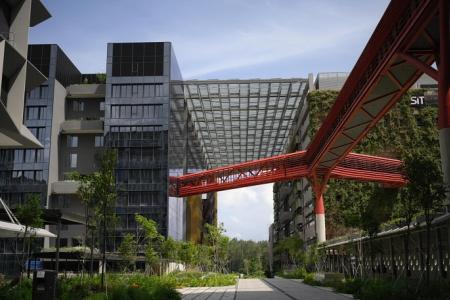First wave of tenants to move into Punggol Digital District
Singapore robotics firm dConstruct will be among the first wave of tenants to move into Punggol Digital District (PDD) in 2025.
For the company, which plans to test various robots – including a humanoid concierge robot and others that specialise in deliveries and surveillance – there is no other place to be.
A major attraction for companies like dConstruct is the district’s open digital platform (ODP), Singapore’s first estate-wide computer operating system that allows robots, surveillance cameras and all kinds of sensors to plug in and be controlled centrally, without needing to fuss over the underlying control infrastructure.
For instance, companies do not need to configure their systems for different areas, like how a mobile app might work exclusively on iOS but not on Android.
Mr Chinn Lim, dConstruct’s chief executive, said the ODP enables robots to navigate lifts and turnstiles throughout the district’s eight blocks that occupy an area equivalent to 70 football fields. These robots can deliver items, clean the premises or look out for safety.
“It was difficult to say no (to relocating to PDD),” said Mr Lim. “There’s nowhere else in Singapore that has this kind of technology at a district scale.”
His company is slated to collect its keys in February and move out of its office in one-north by September.
The ODP is central to the smart district’s plans to draw the likes of dConstruct to populate the enterprise park – Singapore’s take on the US’ Silicon Valley.
More than two-thirds of the PDD’s office spaces have been taken up, attracting banks, cyber-security organisations and major tech names like Boston Dynamics, a robotics firm famous for its robot dog and humanoids.
Local systems integration company Delteq and the Association of Information Security Professionals will relocate there by the middle of 2025.
Software coders, engineers and cyber sleuths from OCBC Bank, UOB and Singapore’s Cyber Security Agency will join them by 2027.
Several food joints, such as Astons, Sushi-Go and Playmade, are expected to open in March, while nearly half of the Singapore Institute of Technology’s students have relocated to the Punggol campus. The remaining 8,200 students currently at the school’s various campuses will move over by mid-2025.

The novel 50ha business park in the north-east of the island, earmarked to spur innovation, progressively opened in late 2024 and is scheduled for completion by 2026. It is billed as Singapore’s first Smart Nation business district.
In October 2024, Prime Minister Lawrence Wong referred to it as the nation’s first smart district, where companies, research institutes and government agencies spearhead technological innovation. He made these remarks at the launch of Singapore’s Smart Nation 2.0, the first major event held at the PDD.
The PDD is another enterprise hub in Singapore, following the launch of one-north in 2001 as a science park focusing on scientific and technological research and development. One-north similarly adapted Silicon Valley’s approach in clustering start-ups and big players to drive innovation.

Mr James Tan, director of JTC Corporation’s smart district division, describes the ODP as a smart city operating system akin to a mobile operating system.
It can seamlessly analyse the energy use of tenants, footfall in the district and the deployment of robots.
The platform was trialled on a smaller scale at the JTC Summit office building in Jurong East. At the PDD, it will be taken to another level, due to the sheer volume of interconnected offices, utilities and public facilities, including a train station.
Punggol Coast MRT station opened its doors in December, connecting the district to Outram Park through the city centre via the North East Line.

Some 20,000 sensors scattered across the district will track metrics such as movement, temperatures and energy consumption. The sensors track all moving parts of the district, including the centralised waste management system that transports trash from buildings via a 4km underground conveyance system.
All activities are monitored on dashboards at a single command post, where the smart district’s digital twin – a 3D computer replica of the PDD to keep tabs on conditions in the park – is also displayed.
The platform reduces the guesswork needed to manage a multitude of systems that underpin smart districts and guzzle high amounts of energy for equipment like air-conditioning, artificial intelligence (AI) systems and numerous sensors.
For instance, the ODP analyses the distribution of people within a building through surveillance cameras and security gantries where workers tap to enter.
With this real-time data, it can recommend a schedule for the lifts, such as “parking” lifts on floors with high foot traffic, thus reducing electrical consumption and enhancing convenience for the users.
The same logic applies to the district’s smart cooling system that serves offices, malls, hotels and the train station within the estate.

The ODP’s AI controls the temperature settings of the air-conditioners in each location by taking into consideration the footfall, historical data and live weather information.
The concept builds on the centralised cooling system at the “eco-smart” Tengah housing estate that sends chilled air to rooms within a housing block. This is said to offer up to 30 per cent in savings on power bills for residents in the long run.
Mr Tan of JTC hopes the smart district will be a model for future smart business and residential areas in Singapore, and that the proximity to other tech players and services such as the ODP will attract more companies.
Get The New Paper on your phone with the free TNP app. Download from the Apple App Store or Google Play Store now


